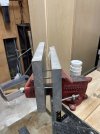- Joined
- Dec 15, 2010
- Messages
- 645
Good Morning everyone, I have heat treated about 60 blades in CPM Magnacut and about 20% of those blades have warped. My HT recipe is as Larrin suggests in his article. I do a 20 minute soak at 2050*F followed by a plate quench and a LN treatment. I then temper at 350*F for 2 two hour cycles.
I have found that my blades are going into the liquid nitrogen straight, but when I pull them out for tempering, some of them have a bow to them. Usually it is just a bow, but I have had the occasional twist develop as well. I am using .100" to .156" steel, with no bevels ground pre heat treat.
To try and correct this warp, I shim and clamp these blades during tempering, but it only helps so much. Does anyone have any ideas or suggestions on how to prevent or correct this issue?
I have found this steel to be less prone to warp than Nitro-V but quite a bit more prone to warp than S35VN.
I have tried straightening some of these blades post heat treat and have had a little success, but I have also snapped a couple of blades trying to get the warp out. In the end, I can take these blades to my surface grinder to clean them up, but I would like to avoid that as much as I can.
Any words of advice are welcomed and appreciated.
--Jared
I have found that my blades are going into the liquid nitrogen straight, but when I pull them out for tempering, some of them have a bow to them. Usually it is just a bow, but I have had the occasional twist develop as well. I am using .100" to .156" steel, with no bevels ground pre heat treat.
To try and correct this warp, I shim and clamp these blades during tempering, but it only helps so much. Does anyone have any ideas or suggestions on how to prevent or correct this issue?
I have found this steel to be less prone to warp than Nitro-V but quite a bit more prone to warp than S35VN.
I have tried straightening some of these blades post heat treat and have had a little success, but I have also snapped a couple of blades trying to get the warp out. In the end, I can take these blades to my surface grinder to clean them up, but I would like to avoid that as much as I can.
Any words of advice are welcomed and appreciated.
--Jared



